Introduction
Long-term ocean warming, combined with climate drivers such as the El Niño-Southern Oscillation (ENSO), is leading to an increase in the frequency, duration, and intensity of marine heatwaves (MHWs; Frölicher and Laufkötter, 2018; Oliver et al., 2018). Extended scientific projections of environmental and biological change due to global warming (e.g., Hobday and Lough, 2011; Pethybridge et al., 2020) have led to efforts to plan for a changed future through adaptation research programs (e.g., Creighton et al., 2016; Ling and Hobday, 2018) and the development of adaptation plans (e.g., Fulton et al., 2020). MHWs impact the distribution, abundance, and underlying adaptive capacity of many marine species (Cavole et al., 2016; Smale et al., 2019; Coleman et al., 2020) and their habitats (Babcock et al., 2019), with flow-on economic and social effects for marine industries that rely on biological resources (Mills et al., 2013; Smith et al., 2021). Decision-makers involved in industries such as fishing, aquaculture, conservation, and tourism have experienced MHWs in recent years, and there is now considerable interest in preparing for and avoiding the negative impacts of such events (Mills et al., 2017; Spillman et al., 2021; Stevens et al., 2022). Forecasting these events on subseasonal to seasonal (S2S) timescales is one way to improve stakeholder preparedness (Spillman and Hobday, 2014; Jacox et al., 2022; Hartog et al., 2023). Development of MHW forecasting has been notable in Australia, particularly in the southeastern part of the country, where rapid warming (Hobday and Pecl, 2014) compounds the risk from MHWs (Oliver et al., 2017a).
Serious impacts from past MHWs (see K.E. Smith et al., 2023), in conjunction with both record-breaking sea temperatures in the Northern Hemisphere during 2023 (Cheng et al., 2024) and increased MHW risk in Australian waters due to developing El Niño conditions (Hobday et al., 2023), raised stakeholder awareness of the need to prepare for the upcoming summer. New seasonal MHW forecasting capacity (Hartog et al., 2023; G.A. Smith and Spillman, 2024) had the potential to provide Australian marine resource users with an unprecedented lead time to plan and implement strategies to mitigate MHWs, while also increasing awareness around marine extremes. However, researchers and management agencies recognized that there was limited understanding by marine users regarding the risk of MHWs for the 2023/2024 summer. Accepting that scientific knowledge is critical for allowing decision-makers to better prepare and consider risk mitigation, a series of stakeholder briefings were planned and delivered. Here we describe a hierarchy of ocean climate briefings from national to local scales, underpinned by new MHW forecasts, that were used to prepare Australian marine decision-makers for the 2023/2024 summer, together with user responses and lessons. This briefing approach can be replicated and built on in future years and developed for locations where forecasting is currently unavailable.
Establishment and Coordination of Briefings
Discussions commenced in May 2023 about the potential importance of national marine climate briefings, but it was apparent that while Australia has world-leading science, institutions, and scientists willing to brief decision-makers, there was limited capacity to meet all anticipated briefing needs directly. Scientists at national agencies (Commonwealth Scientific and Industrial Research Organisation [CSIRO] and Bureau of Meteorology [BOM]) and a research funding agency (Fisheries Research and Development Corporation [FRDC]) initially formed a working group and proposed a series of virtual national ocean climate briefings to present information to the seafood sector through the summer of 2023/2024. Demand for more regional and local information led to expansion of the working group, establishing an ongoing collaboration to ensure coordination of a hierarchy of briefings across multiple scales (Figure 1). This allowed for sharing of materials and approaches (author Spillman, pers. comm., June 2024), minimizing duplication, and ensuring that scientists were supported and not overloaded. The focus of the working group was to plan and refine the process for, rather than the content of, effective briefings. The welfare of researchers, managers, and business owners in this space was also considered, including recognition of the potential risk of climate and ecological grief resulting from increased exposure to confronting environmental risk discussions (e.g., Cunsolo et al., 2018). The working group noted that in briefings it was important to emphasize the opportunities and advantages provided by forecasts for decision-makers and end users. The group also discussed coping strategies for researchers as part of the regular meetings.
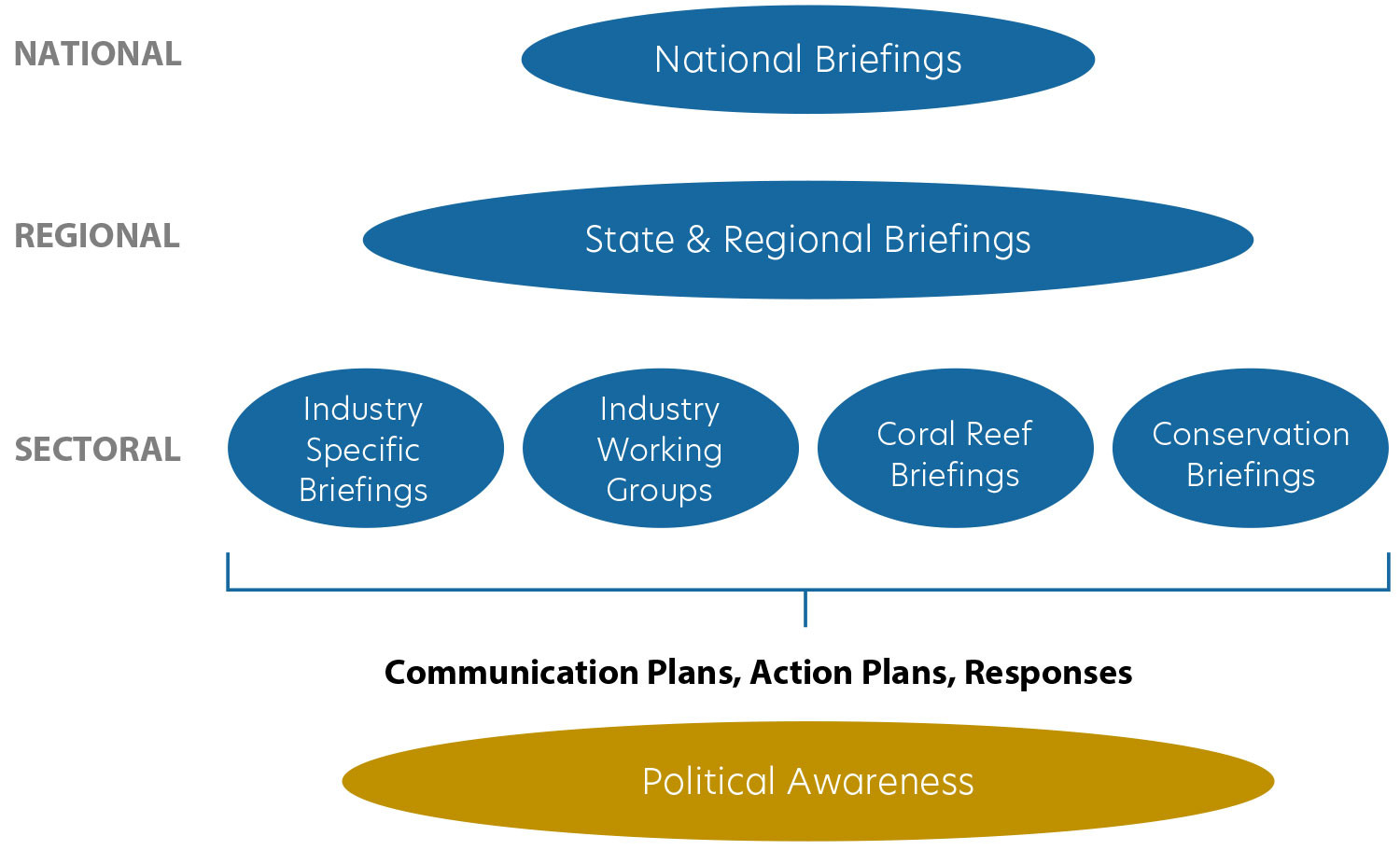
FIGURE 1. A hierarchy of briefings was used to share marine heatwave information to decision-makers across Australia’s marine jurisdictions, including those in seafood, coral reef management, and conservation. These briefings informed a range of communication and action plans, user responses, and increased political awareness. > High res figure
|
National Ocean Climate Briefings Based on Key Ingredients
A series of six 30-minute online national briefings, each followed by 30 minutes of questions, was delivered by authors Hobday and Spillman, facilitated by author Allnutt, from June 2023 to May 2024. More than 100 people from across the marine sector attended each briefing, including national and state fisheries managers and executives, industry participants, scientists, and policymakers across Australia’s eight fisheries jurisdictions. The briefings were advertised by circulating invitations through existing stakeholder networks and the research community. By the third briefing, the audience had broadened to include national and state conservation managers. The recorded briefings were then placed on YouTube, which further facilitated information dissemination (https://www.frdc.com.au/climate-change).
The approach taken with the briefings and associated communication activities involved the following principles: (1) identifying and knowing the audience; (2) designing engaging and informative presentations; (3) communicating the latest science, along with assumptions and uncertainties; (4) conveying information at multiple temporal scales; (5) framing communication around the evidence, possible impacts, and what the audience can do in response; (6) providing opportunities for questions and discussion; and (7) offering opportunities for feedback that is then incorporated into future briefings.
Knowing your audience includes consideration of the “who” (e.g., government, industry), the “where” (scale of concern, i.e., national, regional, local), the “what” (e.g., ocean, atmosphere, land), the “when” (e.g., time of year, how far into the future), and the “why” (e.g., the forecast, issues, concerns, decisions). The “why” is the most critical element in tailoring an effective briefing for an audience—a strong understanding of what the user concerns are and what decisions are made and when (e.g., Eveson et al., 2015). Deep knowledge supplied by regional and local experts, drawing on their experience and that of the region, builds confidence and trust in the information supplied. The extent to which the audience can then respond to forecast information depends on their agility (Hartog et al., 2023) and will inform response plans accordingly.
There are many ways to build an engaging and informative presentation, depending on the audience. In these briefings, the scene was set by describing recent and current atmospheric and marine conditions, and the influence of any active climate drivers. As some in the audience were likely new to seasonal forecasting, concepts were introduced in plain language, with a minimum of technical jargon. To build trust in the forecasts, we showed forecast performance for recent events as well as for large historically important climate events (e.g., significant MHWs in that region in the past five years).
A frank discussion about forecast strengths and weaknesses, with the acknowledgment that models are not always right, is generally appreciated by audiences. For example, seasonal forecast models cannot currently predict tropical cyclones (Camp et al., 2023), which can disrupt marine heatwaves. This was an important consideration when communicating forecast information to managers across tropical northern Australia. Heatwave forecasts are also more uncertain in inshore and shallow waters, which is important to note for users operating in these spaces. With that in mind, forecast skill or accuracy with lead time should be presented with forecast information for the coming weeks and months. Presenting forecast skill effectively to different users can be challenging (Spillman and Hobday, 2014; Siedlecki et al., 2023) and is influenced by the experience and manner of the presenter. However, this step is important in building capacity in decision-makers and empowering them to look at forecast information between briefings. Providing information about where to find the forecast information, relevant points of contact, and when the next briefing is scheduled are important for building both capacity and partnerships.
Information and briefings can be provided at international, national, regional, and local scales. While information shared in scientific publications can build awareness at national and international levels (e.g., Hobday et al., 2023), decision-makers are typically focused on regional and local scales and require more specific detail, including on response options and coordination opportunities. Thus, the specificity of the briefing must increase at local and regional scales, relative to national scales. Likewise, industries operating at a local scale require more specific briefings. Regional briefings can also build capacity across industries and communities and generate shared resources. Finally, research partnerships to advance forecasting uptake can be more impactful at local scales, as this is the scale of many responses.
Each national briefing included an opportunity for feedback in order to refine future briefings to best meet audience needs and preferences. Initial feedback was received through a short survey provided at the end of the briefings, with additional comments captured verbally and via email. There was a high level of positive feedback about the value and design of the briefings. This, along with increasing participation as the series progressed and subsequent interaction between the lead scientists and decision-makers, provided evidence of the impact of the briefings.
To support the national briefings, a range of information products were developed that could be emailed to stakeholders, including fact sheets detailing access to both current environmental conditions and forecast information (e.g., seasonal ocean outlook: http://www.bom.gov.au/oceanography/oceantemp/sst-outlook-map.shtml) (Figure 2). These resources were updated as new information became available and included direct links to each information source.
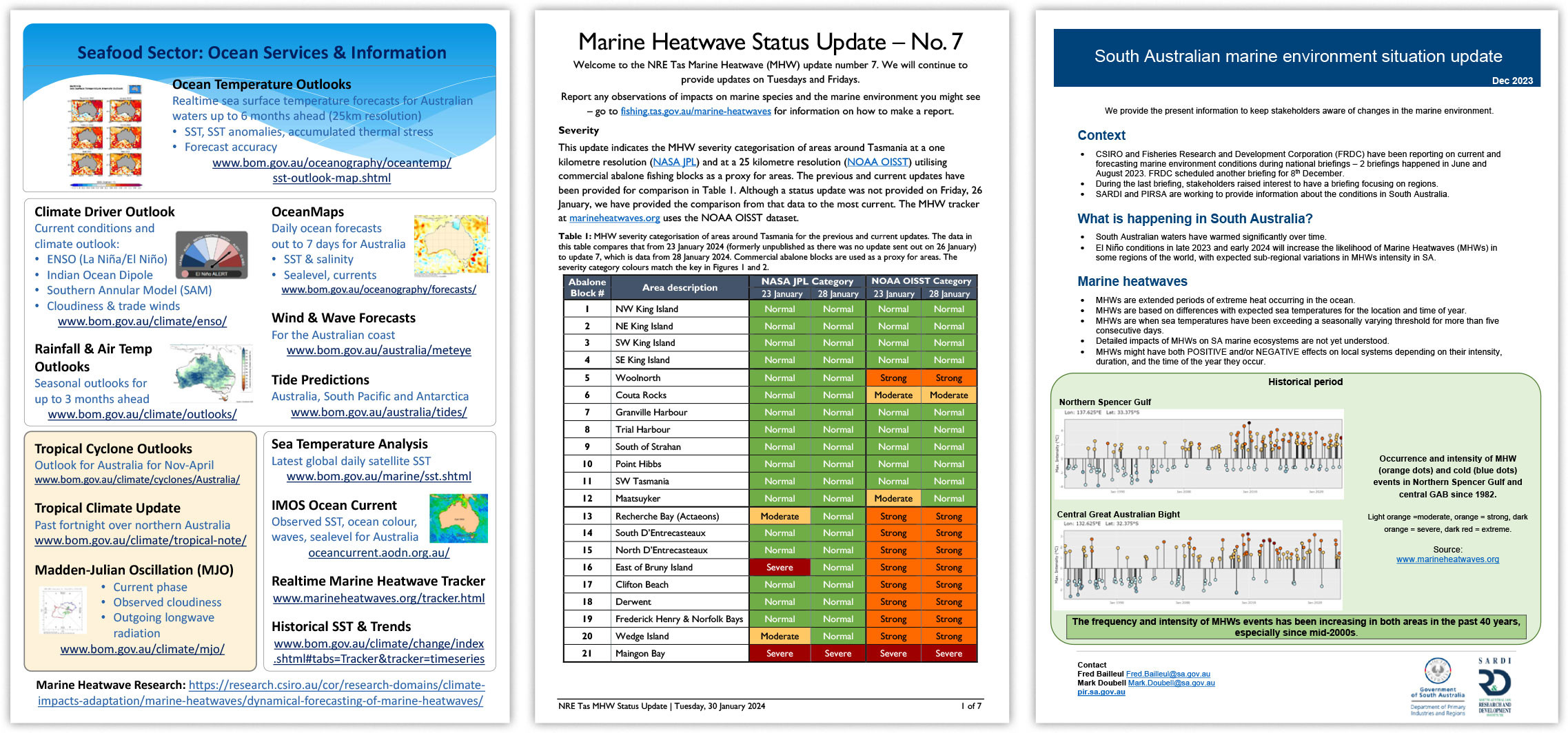
FIGURE 2. These examples show supporting national (left) and state (Tasmania, center, and South Australia, right) marine heatwave information products developed according to regional and stakeholder needs. > High res figure
|
Regional and State Briefings and Information Dissemination
Following the first national briefing, stakeholders requested additional targeted regional and local briefings. We sought engagement from our colleagues who were active in climate and marine research to meet this demand. These briefings covered most of the Australian states and territories and were accompanied by state-specific information products, such as fact sheets, and were important in increasing local political awareness of the risks from MHWs.
Tasmania lies within a global warming hotspot and has an active and well-connected marine research, manager, and stakeholder community (Frusher et al., 2014), with recent experience of a strong MHW in 2015/2016 (Oliver et al., 2017b). Following the first national briefing, a Tasmania-focused briefing of more than 50 decision-makers was held. Sharing of past MHW impacts by attendees emphasized the need for preparation and for use of the preparation time available to further develop response plans. Detailed fishery-specific MHW briefings were delivered to the commercial scalefish and lobster fisheries and oyster growers, as well as to recreational fisher representatives specifically around novel target species. These briefings included likely impacts and mitigation options as well as risks to seafood safety and quality due to MHW conditions (e.g., increased risk of ciguatera and histamine poisoning, and Kudoa parasite). To further increase industry and public awareness, the state marine resource management agency launched an MHW webpage (https://fishing.tas.gov.au/community/fisheries-management/marine-heatwaves) that provides a plain English explanation, actions to take, where to report impacts, and links to further information. Links to the page were shared via Fishing Tasmania social media and the main state agency website. Over the summer, weekly MHW status updates were emailed to industry associations, community organizations, palawa (Aboriginal) organizations, local councils, researchers, and across the state government.
In New South Wales (NSW) following the first national briefing, state government marine researchers briefed NSW Fisheries senior executives on the MHW outlook and the need to rapidly develop a response plan. Following the development of an interim plan, state-focused briefings were held with the NSW Fisheries Advisory Council, Parks Australia, and the NSW Fisheries Scientific Committee. The briefings provided background information on MHWs, potential impacts of MHWs, the 2023/2024 forecasts, and links to current MHW conditions. Informal discussions were initiated with several NSW Department of Primary Industries managers (e.g., Fisheries and Aquaculture Management) and stakeholder groups (NSW Abalone Association). A nine-week social media campaign was developed and launched to share MHW information with the public and stakeholders via Instagram and Facebook every seven days to succinctly communicate current MHW conditions, likely impacts, and how to get involved.
A Northern Australia briefing took place in December 2023, following requests from stakeholders in Northern Territory and Queensland to provide more focused information for tropical northern Australia. This briefing included the impacts of large-scale climate drivers such as ENSO, the Indian Ocean Dipole (IOD), and the Madden Julian Oscillation (MJO) (Risbey et al., 2009) on the region as well as region-specific forecasts for ocean temperature, MHWs, sea level height, and rainfall. Information on tropical cyclones was highly relevant as the north Queensland coast was under the influence of Tropical Cyclone Jasper at the time of the briefing. Examples of how climate extremes previously impacted tropical ecosystems (e.g., mangrove dieback; Babcock et al., 2019) and associated fisheries (e.g., prawn recruitment, Blamey et al., 2022; and lobster mortality, Plagányi et al., 2019) reminded stakeholders what could be expected over the coming summer. The 2023/2024 summer season in Queensland was wetter than typical for an El Niño year, with extreme flooding culminating in a declared fisheries disaster area. Being cognizant of the impact of such extreme weather events on communities is important when providing marine climate updates.
Briefing materials were subsequently distributed and discussed at a number of fishery scientific assessment and management groups to encourage actions such as: (1) tropical rock lobster fishers in Torres Strait reducing packing densities and keeping holding cages for lobsters in deeper cooler water where possible during MHW events; (2) Northern Prawn Fishery stakeholders monitoring forecasts closely and preparing accordingly given potential impacts on prawn recruitment, and bearing in mind a recently revised harvest strategy to better account for extreme climate variability (Plagányi et al., 2023); (3) ongoing monitoring of Gulf of Carpentaria mangrove recovery given known sensitivity to climate extremes (Babcock et al., 2019).
The seafood-targeted Northern Australia briefing was complemented by the fifteenth annual pre-summer workshop organized by the Reef Authority in November 2023. The Australian Bureau of Meteorology and NOAA Coral Reef Watch present targeted climate outlook briefings for the Great Barrier Reef (GBR) at these workshops (G. Smith and Spillman, 2019; Spillman and Smith, 2021). Forecast information is incorporated into monitoring, ministerial briefings, and operational plans. Reef managers are experienced in using seasonal forecast information and regularly utilized forecasts as the summer progressed.
In South Australia (SA), the national briefings led to the production of a regional marine environment situation fact sheet by state government marine researchers (Figure 2). This consisted of background information on MHWs, the historical regional trend in MHW frequency and intensity, current regional conditions, and the 2023/2024 forecasts. The fact sheet was shared with those responsible for SA fisheries management and seafood sectors’ Fisheries Executive Officers. This fact sheet will be revised quarterly and expanded to other climate indicators and their impacts on the local marine environment. Stakeholders have also requested that similar documents be produced for individual fishery sectors.
In Western Australia (WA), quarterly ocean climate reports have been circulated (via email) among fisheries researchers, managers, educators, industry peak bodies (advocacy groups), and public interest groups since 2019. These reports provide a synthesis of key climate information that influences WA marine state waters, including regional sea surface temperature profiles, active cyclones, and any MHW events, together with seasonal forecast information. The accompanying narrative captures the impacts of active climate drivers (e.g., ENSO, IOD) on the strength and position of the Leeuwin Current, as it influences ocean temperatures around WA. For WA, the risk of MHW events is generally associated with La Niña events for the southwest region and El Niño events for the northwest region. Productivity of many WA fisheries had been significantly impacted by the 2010/2011 extreme MHW (Caputi et al., 2019), a La Niña year, and so seasonal forecasts are often presented at stakeholder meetings and used to inform fisheries assessments. State agencies and research institutions that manage WA reefs also rely on seasonal sea surface temperature predictions, presented in targeted monthly climate briefings during the periods of high concern.
In all states, local and regional information was shared more widely in a number of ways to build further awareness:
- Industry newsletters (e.g., Seafood Industry Tasmania, 2023)
- Media outlets (e.g., Clarke, 2023; Dawkins, 2023)
- Shared by the FRDC via email and social media and in FRDC online news
Stakeholder Responses to Briefings
Potential response options to the forecasts were outlined (Hobday et al., 2023) in the national briefings, based on four phases (Spillman et al., 2021; Figure 3). Phase 1 is the risk assessment phase when an increased risk of MHW is first predicted, as was indicated in June 2023 by forecasts for spring and summer in southeast Australia, due to developing El Niño conditions. In Phase 2 (preparation), it is essential to plan responses and commence preliminary “no regrets” actions, or those requiring a longer lead time. In Phase 3 (reaction, during an MHW event), most actions are implemented; if well planned in Phases 1 and 2, they should reduce some of the impacts of the event. Finally, after the MHW has ended, Phase 4 (recovery) involves evaluation of the response efficacy, and adjustment of plans for implementation in future. Longer-term response options, or those that require a longer preparation window than the forecast could provide, can also be planned and tested. A range of responses were initiated by different stakeholders, including industry (I), researchers (R), managers (M), and policymakers (P) in local or national government (Figure 3).
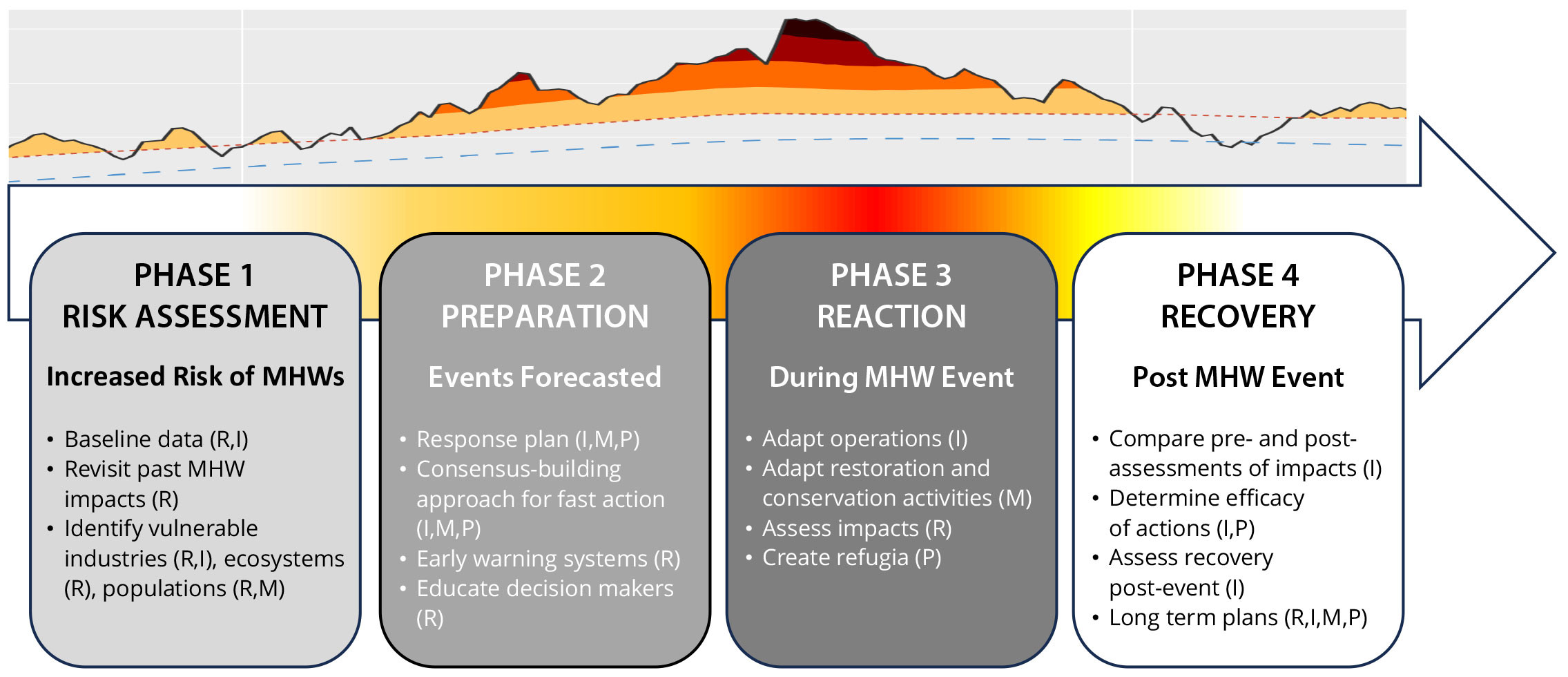
FIGURE 3. Stages for marine heatwave (MHW) preparation, as discussed in national briefings, together with examples of actions taken at each stage in southeast Australia during June to December 2023. An example MHW time series is shown above the stages. Stakeholders are included as follows: industry (I), researchers (R), managers (M), and policymakers in local or national governments (P). Modified from Hobday et al. (2023). > High res figure
|
Draft plans for state response to this and future events were developed by two jurisdictions where MHW events were forecast in summer 2023/2024. In Tasmania, the Department of Natural Resources and Environment (NRE) began working with research organizations, industry, palawa community organizations, and other government agencies to develop an MHW response plan in October 2023. The plan, scheduled for release in August 2024, included information regarding (1) detection, (2) risk assessment, (3) response, (4) emergency response, (5) communication, and (6) evaluation and preparedness. Industry responses included increased monitoring of dissolved oxygen in the live holding tanks on rock lobster fishing vessels to maximize catch survival throughout the supply chain. Recreational fishers were encouraged to switch target species to reduce pressure on traditional targets that would be negatively impacted during the MHW. A short-term temperature monitoring framework for Tasmania’s seafood industry during MHWs was developed to supplement existing in situ long-term monitoring (IMAS, n.d.) in order to support industry and government responses to future MHW events. Coordinated sample collection was implemented for abalone viral ganglioneuritis (AVG; a risk from MHW). Similarly, based on observations of sublethal physiological stress in abalone during the 2015/2016 Tasman Sea MHW, a tactical sampling program was rapidly initiated by the University of Tasmania for wild abalone populations before, during, and after the 2023/2024 MHW. In southern Tasmania, conservation interventions for the critically endangered red handfish were also initiated, based on concerns that lethal temperature thresholds would be exceeded (Box 1). This intervention is the first preemptive marine rescue of a protected species in Australia. The MHW forecasts helped decision-makers evaluate the risks, provided background information, and led to a new protection approach for this endangered species.
NSW rapidly developed an interim response plan by November 2023 to guide state government response prior to, during and following an MHW event (https://www.dpi.nsw.gov.au/__data/assets/pdf_file/0008/1500956/DPI-Marine-Heatwave-Response-Plan.pdf). Given the lack of existing response plans for temperate marine habitats, coral bleaching response plans were used as a framework (e.g., Reef Resilience Network, 2024). The draft plan includes:
- An early warning system for the likelihood of MHWs and early detection of any observed MHW impacts.
- Planned responses when an MHW is present and biological impacts are detected. Responses will depend on the severity of the MHW and the biological impacts and will include ongoing monitoring as well as an incident response framework for coordinating response actions.
- Management actions during and following a MHW incident to boost resilience and promote recovery of species, habitats, and industries, developed in consultation with managers and stakeholders.
- A communications strategy to ensure consistent, credible, and accurate information is shared about the likelihood, potential impacts, and onset of MHW events; responses and management actions; and subsequent recovery. The plan will outline suggested timing, triggers, and types of communications that could be used.
Data collection efforts were also initiated in some regions in NSW. Following forecasts of MHWs across eastern Australia, researchers within the Great Southern Reef Research Partnership coordinated reactive MHW sampling across the east coast. They gathered data on a variety of marine species and habitats to improve understanding of MHW impacts and responses. Researchers mobilized to tag kelp plants across 1,000 km of the east coast to test whether certain habitat characteristics conferred greater resilience to MHWs that could be utilized in management and conservation strategies (Coleman and Wernberg, 2020; Gurgel et al., 2020).
Forecast Performance
These forecasts performed well and supported decision-making processes. Moderate to severe MHW conditions were predicted for southeast Australia in June 2023, and these conditions subsequently emerged along the east coast of Australia, from NSW to Tasmania during the austral spring (September) and summer (Figure 4). These MHW conditions were then forecast to persist for several months in southeast Australia, also subsequently observed (right-hand column of Figure 4). Through this effort, it was clear that for forecast information to be used and trusted by decision-makers, it must be useful and usable (author Spillman, pers. comm., June 2024). These forecasts had a suitable resolution and domain, and model skill was verified against observations. The forecasts were usable with skill on timescales relevant to decision-making, interpretable by end users, and delivered in a practical format. Forecast information presented in the national briefings included descriptions of trial MHW products that were under development as part of a research project but not yet publicly available.
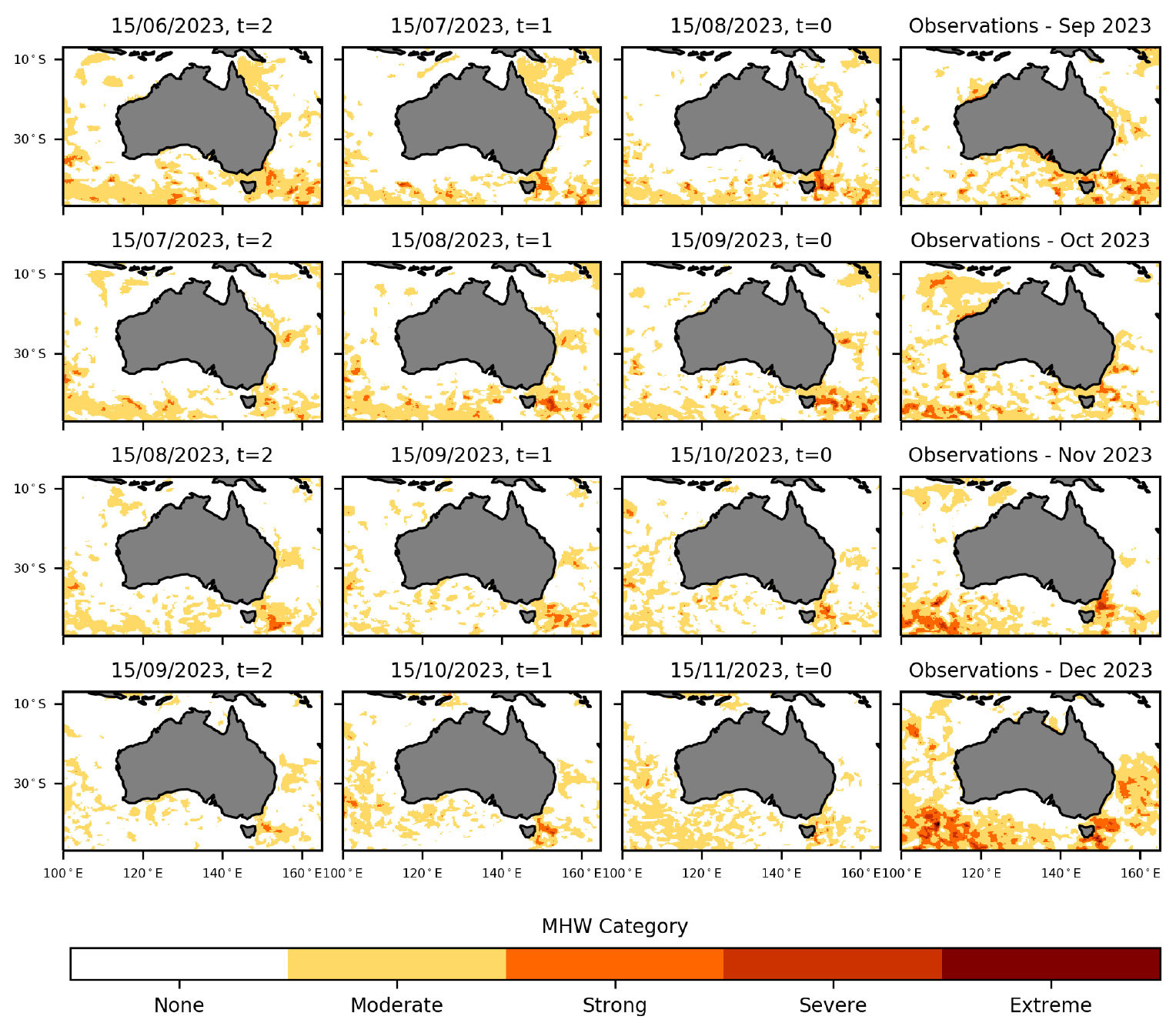
FIGURE 4. Category of forecast and observed MHW conditions during 2023. In this example, the trial forecast was issued on the 15th of each month from June to November 2023, forecasting each month from September to December 2023. Forecast lead time, t, in months is shown for each forecast, and observed conditions in the right column. Forecast information is based on ACCESS-S2 model output (Wedd et al., 2022; G.A. Smith and Spillman, 2024), and the observed MHW metrics are constructed using the Reynolds OISSTv2.1 dataset (Reynolds et al., 2007). Both use a historical baseline of 1982–2018. > High res figure
|
The ability to use a forecast depends on the agility of the decision-makers in each sector (Hartog et al., 2023), and the capacity to alter normal operations in the case of seafood sectors. In some cases, previous barriers to actions were removed, such as in the regulatory environment around species rescue (Box 1), while the intensity of predicted MHW conditions coupled with strong leadership resulted in response options prepared at a range of scales. Media interest in El Niño and forecasts of MHWs may also have increased social expectations for action. Recognition of a gradual increase in summer sea temperatures, together with recent MHW events, has enabled adjustments to post-harvest practices during peak-temperature periods (e.g., avoid warmer regions, restrict fishing to early morning, cease fishing when air temperatures exceed critical thresholds). Forecasts of impending MHW events enabled the post-harvest sector to enact changes earlier. However, despite the early warning that was provided, not all impacts were avoided; for example, Tasmanian salmon aquaculture reported minor fish kills during periods of elevated temperature (MacDonald, 2023). When impacts cannot be avoided, marine insurance offers one alternative, and in a warming world may become an increasingly important adaptation action (e.g., Watson et al., 2023).
Future Directions
The experience and approach we have described here, with hierarchies of briefings supported by a wide range of information to support preparation and response options, was possible through advances in seasonal MHW forecasting that increased the preparation time for response (Hartog et al., 2023). This new capacity reduces the element of surprise that has been used to avoid climate action in the past. Capacity for response planning was improved by the strong engagement of a wide range of marine stakeholders, supported by state-based FRDC extension officers. The researchers who presented national and regional climate briefings came from many agencies; importantly, they were willing to share and learn communication strategies from each other and to modify approaches based on feedback. While improved automation and delivery of MHW information may facilitate uptake and action, too much automation would not allow the discussion and learning that result from formal briefings. The success of the approach described here does raise expectation that science can continue to aid climate responses, which is a risk as the pace of change accelerates. Expectation management about forecast accuracy and limitations is important, as noted in the first section.
The forecasted conditions supported rapid mobilization and coordination of research networks during MHW conditions to enable consistent data collection and field sampling across large regions. In addition to coordinating rapid collection of biological data, deployment of real-time in situ temperature data loggers is needed to ground truth MHW forecasts and understand subsurface patterns. In response to the forecasts for 2023/2024, one agency (IMAS) secured funding for deploying additional data loggers for rock lobster and octopus fisheries for the duration of MHWs (White, 2023). Real-time loggers attached to, for example, marine park moorings or buoys could also provide environmental data at point locations over large scales to assess MHW expression, and to calibrate trends from sea surface temperature data products. Australia’s Integrated Marine Observing System (https://imos.org.au/) has implemented an event-based sampling program using ocean gliders to sample before, during, and after MHWs. These research networks need to develop coordinated plans with pre-established sampling protocols for rapid and efficient responses to future events.
Stakeholder feedback has strongly focused on the need for forecast information at local scales, which will require downscaling and increased data collection for forecasting additional physical fields (e.g., subsurface temperature). This recognition of the importance of in situ environmental data should increase industry participation in research partnerships and encourage marine industries to invest in research to address emerging MHW knowledge gaps. This includes working more closely with Australia’s First Nation’s peoples to complement insights based on traditional ecological knowledge that has accumulated over thousands of years. To extend the reach and effectiveness of briefings, plain language (and preferably translated) summaries would also be helpful, while recognizing any sharing of recorded information that relates to traditional knowledge and cultural heritage requires permission and appropriate acknowledgment (e.g., Bay et al., 2023). Ocean forecasts of MHW conditions have allowed some preparation by marine decision-makers, yet there is also a need to extend this information to ecological forecasting (Sun et al., 2022, Siedlecki et al., 2023). Previous research has highlighted the sensitivity of supply chains to extreme events and the need to strengthen the resilience of seafood supply chains (e.g., Plagányi et al., 2014; Subramaniam et al., 2023). Now, forecasts can also forewarn of potential disruptions to supply chains and encourage consideration of research advice to mitigate these risks.
The responses described here were generally autonomous (e.g., Pecl et al., 2019), but the experience of preparing for each phase (Figure 3) associated with extreme event forecasting should lead to greater future coordination. Integration of response plans should reduce the chance of actions in one sector having a negative impact on another. A critical step in Phase 4 is the examination of responses and their effectiveness to improve preparedness for the next event. Experience this summer has already assisted several management agencies in considering integration of climate risk with other ocean management challenges, including biosecurity, conservation, and recreation. As Australia has a federated management model for the ocean, coordination across jurisdictional boundaries is sometimes difficult, and some issues that response plans can address will need time to be refined. However, these briefings demonstrate that many stakeholders are willing to both coordinate responses and develop response frameworks, which may need to include prioritization frameworks for species and industries that are at high or unmanageable risk. This may necessitate discussion about alternative approaches, such as insurance (e.g., Watson et al., 2023) or the emergency funding that is available in other countries, both of which are under consideration as part of Australia’s National Climate Risk Assessment and National Adaptation Plans.
Conclusion
Marine heatwaves will increasingly impact Australian industries and marine resources into the future as the ocean continues to warm. Subseasonal to seasonal forecasts have an important role to play in helping marine decision-makers to prepare, and for alerting policymakers to the need for action. Here we have described the Australian responses to the first national marine climate briefings in 2023/2024 and the lessons that can help improve stakeholder responses going forward. Ensuring that information is widely available, consistent, and explained to end users will be critical for coping in a warming world. Briefing coordination, clear and effective science communication, and identification of credible supporting information resources can help to both disseminate information to and empower those who need it. Development of usable seasonal forecast products and sharing of user response options can support longer-term climate adaptation that can aid decision-makers’ thinking about necessary future decisions. In Australia and many other countries, national climate risk assessment and national adaptation plans will require integration across both short and long timescales (Hobday et al., 2018). Forecasts and information provision will be critical to the success of climate adaptation to both extreme events and long-term change.
Acknowledgments
We thank the Fisheries Research and Development Corporation for hosting the national briefings, a joint initiative across BOM, CSIRO, and FRDC. We also thank each jurisdiction for involvement in the coordination meetings, and the many stakeholders for supporting widespread engagement in helping marine resource sectors in Australia prepare for effects of climate change. We appreciate the comments of Tim Cowan, Catherine Ganter, and two anonymous reviewers that aided refinement of the manuscript. All materials described here are available from the lead authors. The red handfish rescue was supported by the Department of Climate Change, Energy, the Environment and Water, with broader contributions by the Foundation for Australia’s Most Endangered species..

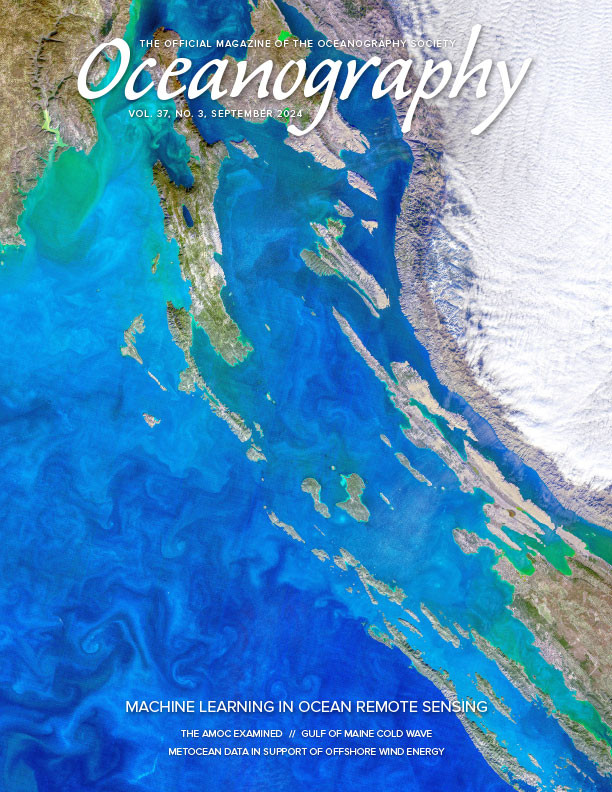



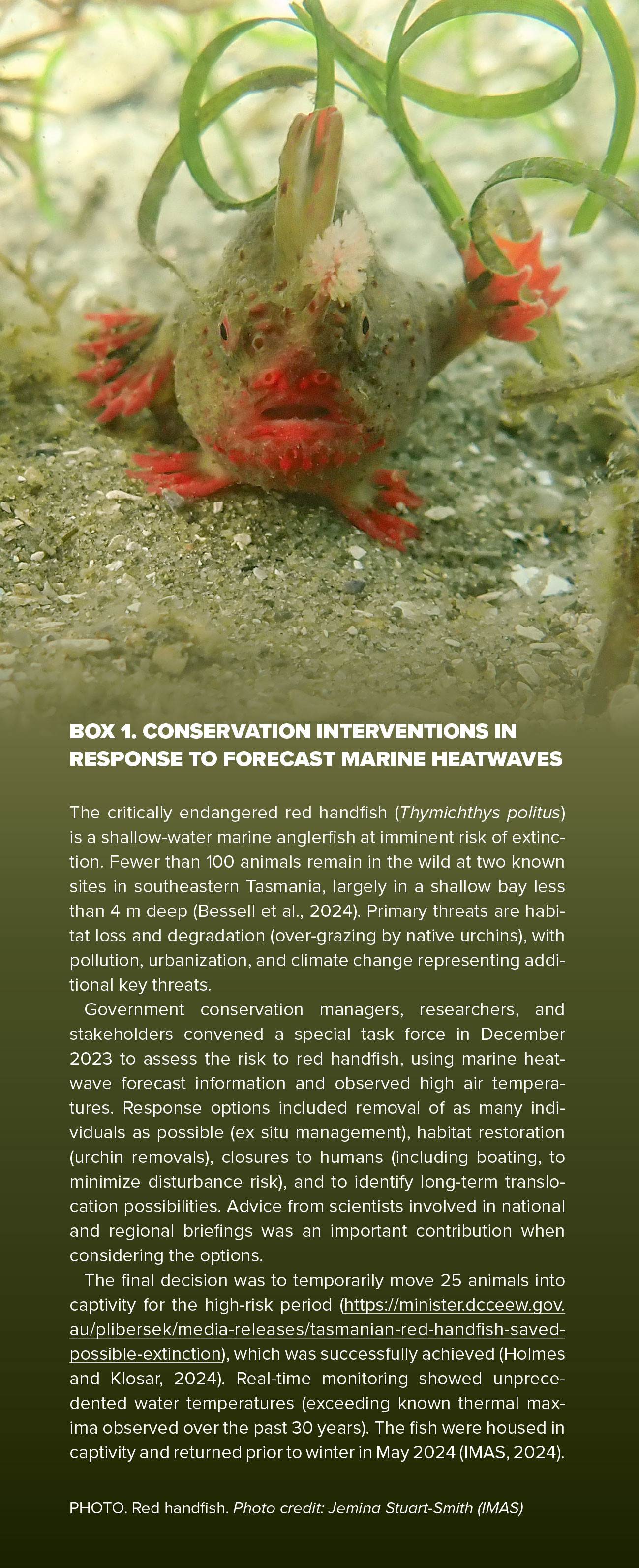 > High res box
> High res box